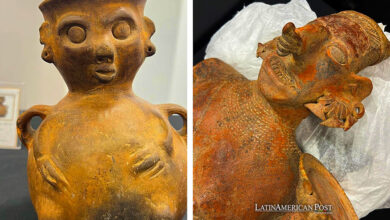Peru Recovers Ancient Pre-Hispanic Helmet in Cultural Heritage Rescue Operation

In a significant cultural heritage recovery operation, Peru’s Ministry of Culture has retrieved a metal helmet over 1,500 years old from a residence in Lima’s San Miguel district, among other archaeological artifacts used in funeral contexts, marking a victory for preserving the nation’s historical legacy.
Unveiling Peru’s Pre-Hispanic Treasure: A Historic Discovery in San Miguel
A remarkable piece of history was recently unearthed in a residential district of Lima, nestled within the modern bustle of San Miguel, shedding light on the rich tapestry of Peru’s pre-Hispanic past. The Ministry of Culture of Peru announced the recovery of a metal helmet dating back over 1,500 years. This find highlights the ongoing efforts to protect and recover the cultural heritage that forms the backbone of the nation’s identity.
This operation, a coordinated effort between the Public Ministry and the National Police and spearheaded by the Ministry of Culture, came to fruition following a tip-off from a social media post that inadvertently revealed the location of these national heritage artifacts. The recovery operation underscores the challenges and triumphs in preserving cultural artifacts, especially those removed from their original context.
The centerpiece of the find, the pre-Hispanic helmet, is a testament to the advanced metallurgical skills of ancient Peruvian societies. Although incomplete, possibly missing a central adornment believed to be made of copper due to the oxidation coloration, the helmet bears the hallmarks of sophisticated craftsmanship that incorporated textiles and potentially other materials in its design. According to preliminary assessments, this ornamental helmet dates from the late Early Intermediate Period (200 BC – 600 AD) and is thought to originate from the northern coast of Peru, an area known for its rich archaeological sites and ancient civilizations, such as the Moche and Lambayeque cultures.
Beyond the Helmet: Recovering Deteriorated Artifacts
In addition to the helmet, the operation recovered other cultural goods, including seven whole and nine fragmented gourds made from organic material. These artifacts, used in funeral contexts by pre-Hispanic societies on Peru’s north coast, were found deteriorated, highlighting the problematic journey many such artifacts face from their creation to their eventual recovery by authorities.
The rescue of these items followed a voluntary handover by the property resident, facilitated by the Ministry of Culture’s Directorate of Recoveries (DRE), which oversees the protection and repatriation of cultural artifacts. The ministry’s swift action to secure and preserve these artifacts reflects a broader strategy aimed at safeguarding Peru’s cultural heritage, which encompasses not only monumental ruins like Machu Picchu but also the myriad of lesser-known yet equally significant artifacts that offer insights into the daily lives, beliefs, and artistic achievements of ancient Peruvians.
Peru’s rich historical landscape is a mosaic of various cultures and civilizations that flourished in the region for thousands of years before the Spanish conquest in the 16th century. The pre-Hispanic period saw the rise and fall of complex societies, each leaving a legacy of architectural, artistic, and technological achievements. From the early hunter-gatherer societies to the sophisticated empires of the Incas, Peru’s ancient cultures have captivated historians, archaeologists, and enthusiasts worldwide.
The recovery of these artifacts enriches our understanding of these ancient societies and underscores the ongoing battle against the illicit trafficking of cultural goods. It serves as a poignant reminder of the fragility of cultural heritage and the need for vigilance and cooperation among governmental bodies, law enforcement, and the public to protect these invaluable links to the past.
Citizenry’s Role: A Call to Defend Peru’s Cultural Heritage
The Ministry of Culture’s appeal to the citizenry to actively participate in defending and protecting Peru’s cultural heritage is a call to action that resonates beyond its borders. It highlights the universal value of preserving our shared human heritage for future generations. The collaborative effort between the Ministry of Culture, the Public Ministry, and the National Police in this operation exemplifies the multidisciplinary approach required to tackle cultural preservation.
Also read: “Somos El Mundo”: The Latin Anthem for Haiti United Over 50 Stars Nearly 15 Years Ago
As Peru continues to uncover and reclaim its historical artifacts, each recovery operation adds another chapter to the story of a civilization that, despite the passage of centuries, remains vibrant and alive in the collective memory of its people. The retrieval of the ancient helmet and other artifacts from a home in Lima is not just a victory for Peru but for cultural preservationists worldwide, reaffirming the enduring importance of history, heritage, and the continual effort to safeguard our collective past.





